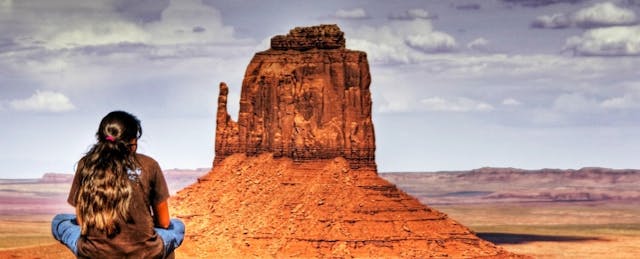The STAR (Service To All Relations) School is located on the southwestern edge of the Navajo Nation, amidst the arid beauty of northern Arizona. The area is remote—with a population density of about six people per square mile—and has been home to the Navajo people for centuries, long before European contact. This is the land STAR students, 98% of whom are Native American, call home.
At STAR, our challenge is to prepare our students for the 21st century while also honoring their unique cultural identity. The history is important to understand. For many decades, the U.S. government operated boarding schools in Native communities with the explicit purpose of destroying ties between students and their Native cultures. Because of this long history of schools denying the value of home culture, many parents view schools as painful places, and many students view schools as irrelevant.
In order to break this cycle and support students’ aspirations and interests, STAR has sought to combine blended learning with culturally responsive, place-based teaching. The result is a school that is not only welcoming and relevant to families, but truly personalized.
A foundation of Navajo values
In many schools, the focus is almost entirely on academics. While these skills are certainly vital, at STAR, we have found that our students are better prepared if we create a school culture that honors and practices the values that have long-sustained the Navajo community.
In our case, those values include the core principles of Navajo Peacemaking, an ancient system of conflict resolution which includes Respect, Relationships, Responsibility, and Reasoning: the 4 R’s. Like many communities in poverty, our families face issues including high unemployment, substance abuse and a lack of resources. But the 4 R’s give our school and families the resilience they need to sustain themselves in the face of these challenges.
Take, for example, daily student interactions. Since there is a well-developed Navajo system of clanship, we teach all of our students how they are related to each other and staff. This supports the practice of relationship building because it connects students to their community and their Navajo roots. We also have whole-school gatherings every Monday morning in which everyone greets each other with a handshake or hug. Through this practice, students who've had a rough weekend at home can recognize they are appreciated. The values create a stronger social-emotional foundation that enables them to focus on learning.
Choice as culturally responsive
Choice is another key element to ensuring the school is culturally responsive. At STAR, we've moved away from a standard curricular approach towards Montessori-style K-3 classrooms in part because of the freedom offered by the model. This autonomy is important considering the history of Native students, and the fact choice has historically been taken from them. However, while we at STAR appreciate the Montessori emphasis on personal choice and responsibility, we also provide activities that teach children how they are interconnected. This way, the core Navajo cultural values of warm and caring relationships are achieved while also allowing for autonomy.
Choice also factors into end of year assessment. Every year, each eighth grader must choose and implement a service project that is guided by STEM skills. It seems to us that blending the Navajo values of service and knowledge with rigorous STEM instruction creates young people who are ready and willing to tackle the challenging problems in our community. Through choice, students are not only able to learn, but to live by the values that have sustained Native populations for centuries.
Values-based personalized learning
Although STAR's curriculum is grounded in ancient values, we also recognize the importance of bringing 21st century technology into the classroom, especially when it comes to personalizing learning. Currently, we are implementing school-wide iReady assessments and diagnostics through our intervention program, as well as using the program to inform instruction. Through the online program, our teachers can become aware of which skills students need to learn and address each student’s particular academic needs.
Technology is not only about assessing students and addressing academic gaps, however. It also helps engage students with their place and culture, and reinforces our values. STAR students, starting in elementary school, learn to make short digital film documentaries, which are then aired at a local college. Some students tell stories from the Navajo culture; others focus on the solar power that runs the school and helps protect their native homeland. This form of storytelling not only exposes students to new technologies, but also allows them to connect with their heritage.
It has indeed been challenging to balance the need for personalized learning with the community-wide desire to keep the Navajo culture and language alive in our community and school. But as I hope you can see, we have found that the personalized attention and choice can actually complement the interests and aspirations of the families and communities our school serves. We are most successful, it seems, when we acknowledge and build on the sustainable values of the families and communities our students in the ways that we treat the students and each other.
Dr. Mark Sorensen has been an educational leader of schools serving Navajo students for forty years. His work as Principal, Superintendent, Advisor and Mentor of indigenous schools has focused on improving the quality of Native American education.


